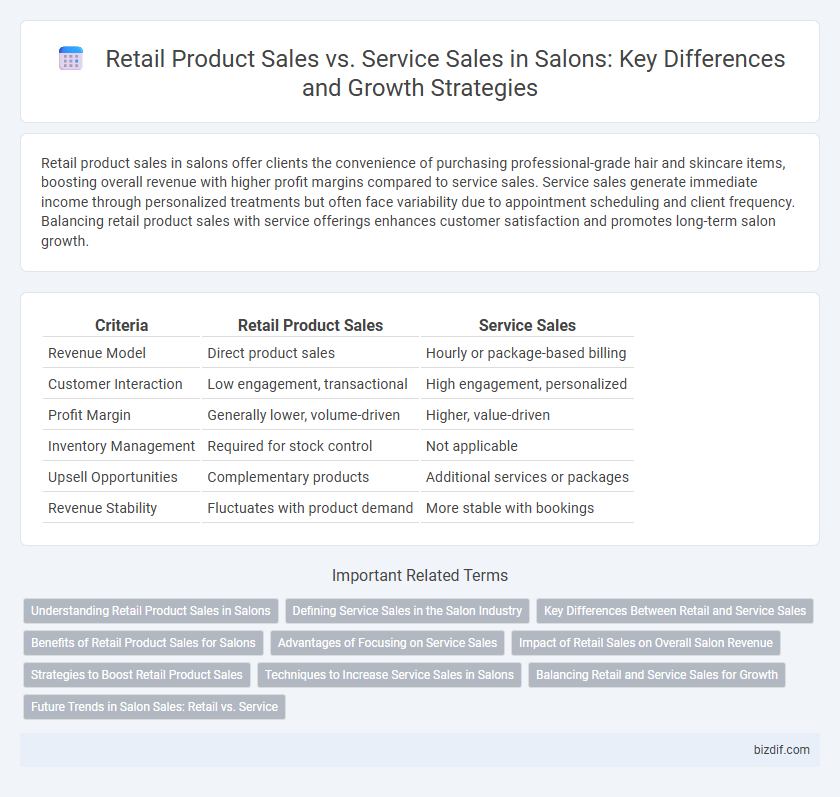Retail product sales in salons offer clients the convenience of purchasing professional-grade hair and skincare items, boosting overall revenue with higher profit margins compared to service sales. Service sales generate immediate income through personalized treatments but often face variability due to appointment scheduling and client frequency. Balancing retail product sales with service offerings enhances customer satisfaction and promotes long-term salon growth.
Table of Comparison
| Criteria | Retail Product Sales | Service Sales |
|---|---|---|
| Revenue Model | Direct product sales | Hourly or package-based billing |
| Customer Interaction | Low engagement, transactional | High engagement, personalized |
| Profit Margin | Generally lower, volume-driven | Higher, value-driven |
| Inventory Management | Required for stock control | Not applicable |
| Upsell Opportunities | Complementary products | Additional services or packages |
| Revenue Stability | Fluctuates with product demand | More stable with bookings |
Understanding Retail Product Sales in Salons
Retail product sales in salons represent a significant revenue stream, often contributing up to 20-30% of total salon income by offering clients professional hair care, skincare, and styling products tailored to their specific needs. Effective retail strategies emphasize personalized recommendations, leveraging the stylist-client relationship to increase product uptake and enhance customer satisfaction. Understanding customer preferences and inventory management further optimizes retail sales performance, driving profitability beyond traditional service offerings.
Defining Service Sales in the Salon Industry
Service sales in the salon industry refer to the revenue generated from professional treatments such as haircuts, coloring, styling, skincare, and nail services. These sales are driven by skilled technicians who deliver personalized experiences tailored to client needs, directly impacting client retention and salon reputation. Unlike retail product sales, which involve selling beauty products, service sales emphasize expertise, time, and client satisfaction as key value components.
Key Differences Between Retail and Service Sales
Retail product sales in salons involve tangible items such as hair care products, styling tools, and beauty accessories directly purchased by clients to use at home. Service sales focus on intangible experiences like haircuts, coloring, spa treatments, and beauty services performed by skilled professionals within the salon. The key differences lie in inventory management, customer interaction, and revenue recognition, where retail sales depend on product stock and immediate purchase, while service sales rely on appointment scheduling, expertise delivery, and customer satisfaction.
Benefits of Retail Product Sales for Salons
Retail product sales generate a steady revenue stream for salons, enhancing overall profitability beyond service appointments. Offering professional haircare and beauty products builds client trust and loyalty, encouraging repeat purchases and at-home brand usage. Retail sales also provide marketing opportunities and elevate the salon's brand presence by showcasing expert product recommendations.
Advantages of Focusing on Service Sales
Focusing on service sales in a salon enhances customer loyalty by delivering personalized experiences that build trust and satisfaction. Service-based revenue often generates higher profit margins compared to retail product sales due to lower overhead costs and the ability to upsell complementary treatments. Prioritizing services also fosters stronger client relationships, encouraging repeat visits and long-term business growth.
Impact of Retail Sales on Overall Salon Revenue
Retail product sales significantly enhance overall salon revenue by providing a steady income stream beyond appointment bookings. High-margin retail items, such as hair care and styling products, boost profit margins and encourage client loyalty through at-home use. Effective product recommendations by stylists increase average transaction value and contribute to long-term business growth.
Strategies to Boost Retail Product Sales
Boosting retail product sales in salons requires targeted strategies such as personalized product recommendations based on client hair type and preferences, creating bundle offers that combine services with complementary hair care products, and training staff to confidently demonstrate product benefits and usage. Implementing loyalty programs that reward product purchases incentivizes repeat buying, while visually appealing and accessible product displays increase impulse sales. Leveraging digital marketing, including social media promotions and online booking integrations that feature product add-ons, further drives retail revenue alongside salon services.
Techniques to Increase Service Sales in Salons
Maximizing service sales in salons requires targeted techniques such as personalized consultations, showcasing service benefits, and bundling services for added value. Training staff to upsell services based on customer needs and preferences increases engagement and satisfaction while boosting revenue. Implementing loyalty programs and seasonal promotions directly tied to service enhancements further drives repeat visits and service adoption.
Balancing Retail and Service Sales for Growth
Balancing retail product sales and service sales in a salon is essential for maximizing revenue and customer retention. Retail sales offer higher profit margins and encourage clients to maintain their beauty routines between visits, while service sales generate consistent cash flow and build client relationships. Integrating personalized product recommendations within service appointments enhances customer satisfaction and drives overall salon growth.
Future Trends in Salon Sales: Retail vs. Service
Shifts in consumer behavior indicate a growing preference for personalized retail product sales alongside traditional service offerings in salons. Innovative technology integration and subscription-based models are driving increased retail revenue, complementing service sales. Data forecasts a balanced growth trajectory, with retail product sales projected to rise by 15% annually, enhancing overall salon profitability.
Retail Product Sales vs Service Sales Infographic

 bizdif.com
bizdif.com